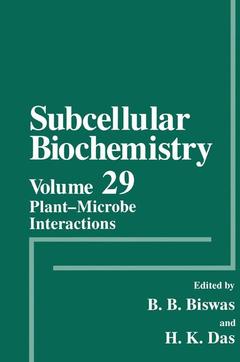Description
Plant-Microbe Interactions, Softcover reprint of the original 1st ed. 1998
Subcellular Biochemistry Series, Vol. 29
Language: English
Subjects for Plant-Microbe Interactions:
Keywords
DNA; Oligosaccharid; Polysaccharid; arabidopsis thaliana; development; plant; plants; protein; synthesis
Publication date: 06-2013
440 p. · 15.2x22.9 cm · Paperback
440 p. · 15.2x22.9 cm · Paperback
Description
/li>Contents
/li>Comment
/li>
Recent years have seen tremendous progress in unraveling the molecular basis of different plant-microbe interactions. Knowledge has accumulated on the mecha nisms of the microbial infection of plants, which can lead to either disease or resistance. The mechanisms developed by plants to interact with microbes, whether viruses, bacteria, or fungi, involve events that can lead to symbiotic association or to disease or tumor formation. Cell death caused by pathogen infection has been of great interest for many years because of its association with plant resistance. There appear to be two types of plant cell death associated with pathogen infection, a rapid hypersensitive cell death localized at the site of infection during an incompatible interaction between a resistant plant and an avirulent pathogen, and a slow, normosensitive plant cell death that spreads beyond the site of infection during some compatible interactions involving a susceptible plant and a virulent, necrogenic pathogen. Plants possess a number of defense mechanisms against infection, such as (i) production of phytoalexin, (ii) formation of hydrolases, (iii) accumulation of hydroxyproline-rich glycoprotein and lignin deposition, (iv) production of pathogen-related proteins, (v) produc tion of oligosaccharides, jasmonic acid, and various other phenolic substances, and (vi) production of toxin-metabolizing enzymes. Based on these observations, insertion of a single suitable gene in a particular plant has yielded promising results in imparting resistance against specific infection or disease. It appears that a signal received after microbe infection triggers different signal transduction pathways.
1 Developmental and Metabolic Adaptations during Symbiosis between Legume Hosts and Rhizobia.- 2 Biosynthesis and Secretion of Rhizobial Lipochitin-Oligosaccharide Signal Molecules.- 3 The Role of Microbial Surface Polysaccharides in the Rhizobium-Legume Interaction.- 4 The Symbiotic Interaction between Azorhizobium caulinodans and Sesbania rostrata: Molecular Cross-Talk in a Beneficial Plant-Bacterium Interaction.- 5 Interaction between Frankia and Actinorhizal Plants.- 6 Strategies to Engineer Plants Resistant to Bacterial and Fungal Diseases.- 7 Plant-Fungal Interactions and Plant Disease.- 8 Arabidopsis thaliana: A Robust Model System for Studying Plant-Pathogen Interactions.- 9 Engineering Resistance against Viral Diseases in Plants.- 10 Biosynthesis and Regulation of Coronatine, a Non-Host-Specific Phytotoxin Produced by Pseudomonas syringae.- 11 DNA Transfer from Agrobacterium to Plant Cells in Crown Gall Tumor Disease.- 12 Import of Agrobacterium tumefaciens Virulence Proteins and Transferred DNA into Plant Cell Nuclei.- 13 Oligosaccharide Elicitors in Host-Pathogen Interactions: Generation, Perception, and Signal Transduction.
This comprehensive volume provides a detailed review of current research covering different modes of interaction between microbes and plants. Included among the interactions examined are : the symbiotic association of Rhizobium, Azorhizobium and Frankia with different plant systems , disease resistance strategies for plants , the role of the agrobacterium system in the formation of tumors, and oligosaccharides produced as a result of the degradation of plant microbial extracellular matrix.
© 2024 LAVOISIER S.A.S.




